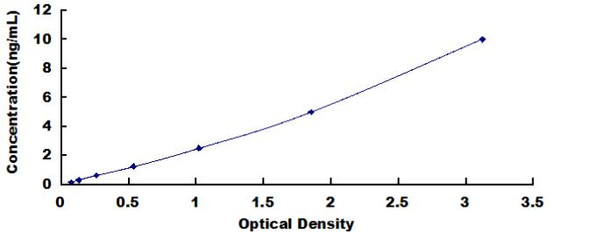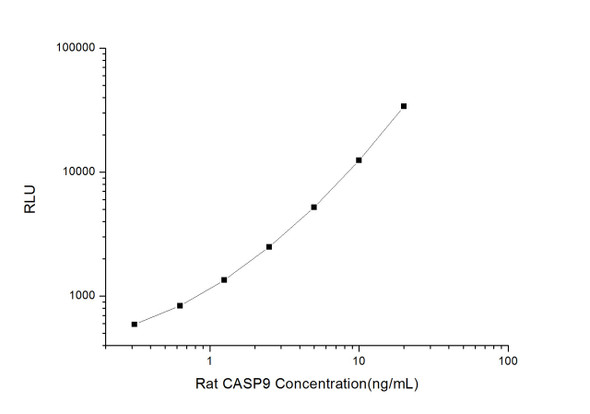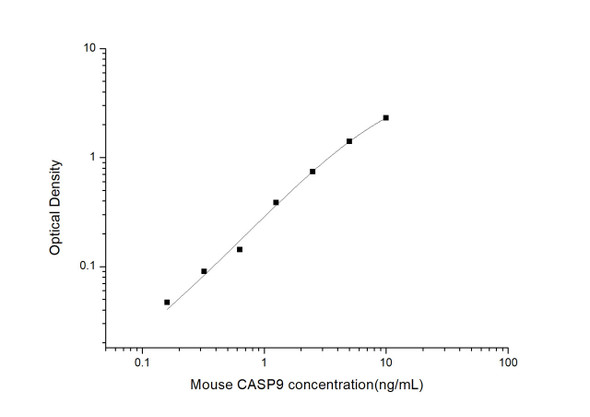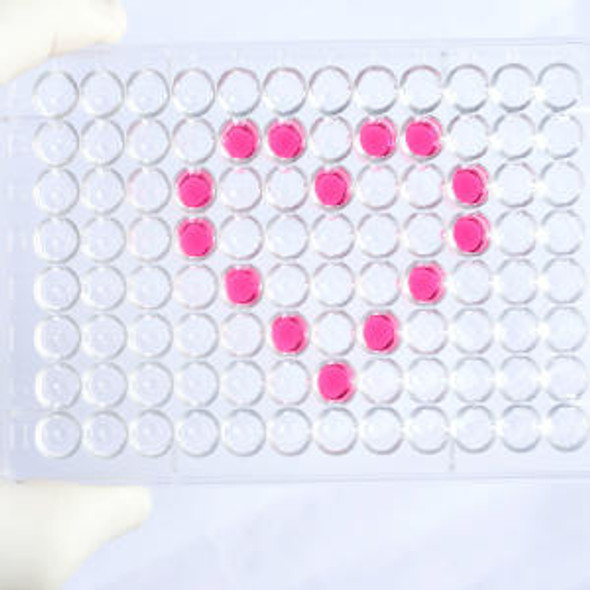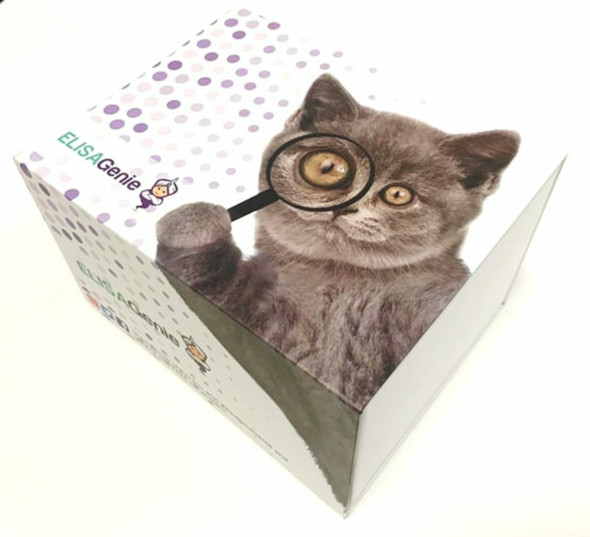Mouse Cell Death ELISA Kits
Mouse CASP9 (Caspase 9) CLIA Kit (MOES00153)
- SKU:
- MOES00153
- Product Type:
- ELISA Kit
- ELISA Type:
- CLIA Kit
- Size:
- 96 Assays
- Sensitivity:
- 18.75pg/mL
- Range:
- 31.25-2000pg/mL
- ELISA Type:
- Sandwich
- Reactivity:
- Mouse
- Sample Type:
- Serum, plasma and other biological fluids
- Research Area:
- Cell Death
Description
| Assay type: | Sandwich |
| Format: | 96T |
| Assay time: | 4.5h |
| Reactivity: | Mouse |
| Detection method: | Chemiluminescence |
| Detection range: | 31.25-2000 pg/mL |
| Sensitivity: | 18.75 pg/mL |
| Sample volume: | 100µL |
| Sample type: | Serum, plasma and other biological fluids |
| Repeatability: | CV < 15% |
| Specificity: | This kit recognizes Mouse CASP9 in samples. No significant cross-reactivity or interference between Mouse CASP9 and analogues was observed. |
This kit uses Sandwich-CLIA as the method. The micro CLIA plate provided in this kit has been pre-coated with an antibody specific to Mouse CASP9. Standards or samples are added to the appropriate micro CLIA plate wells and combined with the specific antibody. Then a biotinylated detection antibody specific for Mouse CASP9 and Avidin-Horseradish Peroxidase (HRP) conjugate are added to each micro plate well successively and incubated. Free components are washed away. The substrate solution is added to each well. Only those wells that contain Mouse CASP9, biotinylated detection antibody and Avidin-HRP conjugate will appear fluorescence. The Relative light unit (RLU) value is measured spectrophotometrically by the Chemiluminescence immunoassay analyzer. The RLU value is positively associated with the concentration of Mouse CASP9. The concentration of Mouse CASP9 in the samples can be calculated by comparing the RLU of the samples to the standard curve.
| UniProt Protein Function: | CASP9: a member of the cysteine-aspartic acid protease (caspase) family. Sequential activation of caspases plays a central role in the execution-phase of cell apoptosis. Caspases exist as inactive proenzymes which undergo proteolytic processing at conserved aspartic residues to produce 2 subunits, large and small, that dimerize to form the active enzyme. This protein is processed by caspase APAF1; this step is thought to be one of the earliest in the caspase activation cascade. Alternative splicing results in two isoforms. |
| UniProt Protein Details: | Protein type:Protease; EC 3. 4. 22. 62; Apoptosis Cellular Component: mitochondrion; cytoplasm; intracellular; nucleus; cytosol; apoptosome Molecular Function:peptidase activity; protein binding; hydrolase activity; cysteine-type endopeptidase activity; SH3 domain binding; protein kinase binding; cysteine-type peptidase activity Biological Process: caspase activation; regulation of apoptosis; DNA damage response, signal transduction resulting in induction of apoptosis; positive regulation of apoptosis; apoptosis; positive regulation of neuron apoptosis; DNA damage response, signal transduction; proteolysis; response to organic cyclic substance; response to DNA damage stimulus; response to UV |
| NCBI Summary: | This gene is part of a family of caspases, aspartate-specific cysteine proteases well studied for their involvement in immune and apoptosis signaling. This protein, the initiator caspase, is activated after cytochrome c release from mitochondria and targets downstream effectors. In mouse, deficiency of this gene can cause perinatal lethality. This protein may have a role in normal brain development. Alternative splicing results in multiple transcript variants that encode different protein isoforms. [provided by RefSeq, Apr 2013] |
| UniProt Code: | Q8C3Q9 |
| NCBI GenInfo Identifier: | 6440942 |
| NCBI Gene ID: | 12371 |
| NCBI Accession: | BAA86895 |
| UniProt Related Accession: | Q8C3Q9 |
| Molecular Weight: | 49,979 Da |
| NCBI Full Name: | caspase9 |
| NCBI Synonym Full Names: | caspase 9 |
| NCBI Official Symbol: | Casp9 |
| NCBI Official Synonym Symbols: | Mch6; APAF-3; CASP-9; AI115399; AW493809; ICE-LAP6; Caspase-9 |
| NCBI Protein Information: | caspase-9 |
| UniProt Protein Name: | Caspase-9 |
| UniProt Synonym Protein Names: | Apoptotic protease Mch-6; Apoptotic protease-activating factor 3; APAF-3 |
| Protein Family: | Caspase |
| UniProt Gene Name: | Casp9 |
| UniProt Entry Name: | CASP9_MOUSE |
As the RLU values of the standard curve may vary according to the conditions of the actual assay performance (e. g. operator, pipetting technique, washing technique or temperature effects), the operator should establish a standard curve for each test. Typical standard curve and data is provided below for reference only.
| Concentration (pg/mL) | RLU | Average | Corrected |
| 2000 | 50201 61241 | 55721 | 55693 |
| 1000 | 22662 25286 | 23974 | 23946 |
| 500 | 11653 10411 | 11032 | 11004 |
| 250 | 5288 5300 | 5294 | 5266 |
| 125 | 2767 2449 | 2608 | 2580 |
| 62.5 | 1368 1254 | 1311 | 1283 |
| 31.25 | 629 719 | 674 | 646 |
| 0 | 27 29 | 28 | -- |
Precision
Intra-assay Precision (Precision within an assay): 3 samples with low, mid range and high level Mouse CASP9 were tested 20 times on one plate, respectively.
Inter-assay Precision (Precision between assays): 3 samples with low, mid range and high level Mouse CASP9 were tested on 3 different plates, 20 replicates in each plate.
| Intra-assay Precision | Inter-assay Precision | |||||
| Sample | 1 | 2 | 3 | 1 | 2 | 3 |
| n | 20 | 20 | 20 | 20 | 20 | 20 |
| Mean (pg/mL) | 102.09 | 202.89 | 737.61 | 92.72 | 184.35 | 727.15 |
| Standard deviation | 10.21 | 21.32 | 78.78 | 7.53 | 19.87 | 62.90 |
| C V (%) | 10.00 | 10.51 | 10.68 | 8.12 | 10.78 | 8.65 |
Recovery
The recovery of Mouse CASP9 spiked at three different levels in samples throughout the range of the assay was evaluated in various matrices.
| Sample Type | Range (%) | Average Recovery (%) |
| Serum (n=5) | 97-109 | 103 |
| EDTA plasma (n=5) | 99-111 | 105 |
| Cell culture media (n=5) | 90-104 | 96 |
Linearity
Samples were spiked with high concentrations of Mouse CASP9 and diluted with Reference Standard & Sample Diluent to produce samples with values within the range of the assay.
| Serum (n=5) | EDTA plasma (n=5) | Cell culture media (n=5) | ||
| 1:2 | Range (%) | 98-112 | 88-104 | 99-115 |
| Average (%) | 104 | 95 | 106 | |
| 1:4 | Range (%) | 98-115 | 99-111 | 86-100 |
| Average (%) | 106 | 105 | 93 | |
| 1:8 | Range (%) | 85-99 | 103-115 | 84-97 |
| Average (%) | 91 | 109 | 91 | |
| 1:16 | Range (%) | 90-102 | 91-101 | 94-111 |
| Average (%) | 95 | 96 | 101 |
An unopened kit can be stored at 4°C for 1 month. If the kit is not used within 1 month, store the items separately according to the following conditions once the kit is received.
| Item | Specifications | Storage |
| Micro CLIA Plate(Dismountable) | 8 wells ×12 strips | -20°C, 6 months |
| Reference Standard | 2 vials | |
| Concentrated Biotinylated Detection Ab (100×) | 1 vial, 120 µL | |
| Concentrated HRP Conjugate (100×) | 1 vial, 120 µL | -20°C(shading light), 6 months |
| Reference Standard & Sample Diluent | 1 vial, 20 mL | 4°C, 6 months |
| Biotinylated Detection Ab Diluent | 1 vial, 14 mL | |
| HRP Conjugate Diluent | 1 vial, 14 mL | |
| Concentrated Wash Buffer (25×) | 1 vial, 30 mL | |
| Substrate Reagent A | 1 vial, 5 mL | 4°C (shading light) |
| Substrate Reagent B | 1 vial, 5 mL | 4°C (shading light) |
| Plate Sealer | 5 pieces | |
| Product Description | 1 copy | |
| Certificate of Analysis | 1 copy |
- Set standard, test sample and control (zero) wells on the pre-coated plate and record theirpositions. It is recommended to measure each standard and sample in duplicate. Note: addall solutions to the bottom of the plate wells while avoiding contact with the well walls. Ensuresolutions do not foam when adding to the wells.
- Aliquot 100µl of standard solutions into the standard wells.
- Add 100µl of Sample / Standard dilution buffer into the control (zero) well.
- Add 100µl of properly diluted sample (serum, plasma, tissue homogenates and otherbiological fluids. ) into test sample wells.
- Cover the plate with the sealer provided in the kit and incubate for 90 min at 37°C.
- Aspirate the liquid from each well, do not wash. Immediately add 100µL of BiotinylatedDetection Ab working solution to each well. Cover the plate with a plate seal and gently mix. Incubate for 1 hour at 37°C.
- Aspirate or decant the solution from the plate and add 350µL of wash buffer to each welland incubate for 1-2 minutes at room temperature. Aspirate the solution from each well andclap the plate on absorbent filter paper to dry. Repeat this process 3 times. Note: a microplatewasher can be used in this step and other wash steps.
- Add 100µL of HRP Conjugate working solution to each well. Cover with a plate seal andincubate for 30 min at 37°C.
- Aspirate or decant the solution from each well. Repeat the wash process for five times asconducted in step 7.
- Add 100µL of Substrate mixture solution to each well. Cover with a new plate seal andincubate for no more than 5 min at 37°C. Protect the plate from light.
- Determine the RLU value of each well immediately.


